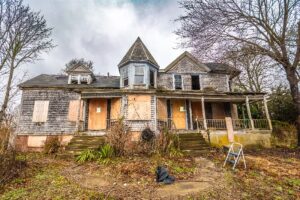WELLFLEET — The formerly grand 19th-century house on Peace Valley Road sat empty and open to the elements all winter despite the town’s efforts, a state program aimed at saving derelict properties, and a commitment made in court by its owner to bring it back to habitable shape by this spring.

On May 16, a Southeast Housing Court judge will decide whether the owner, Boston resident Robert Bonds, has lived up to his side of an agreement made with the state attorney general’s office last July.
Under its terms, the structure must be brought into compliance with the state sanitary code.
While the property has been cleared of debris and some demolition done on its interior, the work has fallen far short of the expectations laid out last summer.
Bonds has owned the 3.7-acre property at 177 Peace Valley Road since 1983, when he bought it for $65,000.
The Queen-Anne style house once numbered among a cluster of grand properties owned by wealthy members of the business community in a neighborhood called Money Hill. But the house has been the subject of nuisance complaints since 2001, and it was condemned by the health dept. for several state code violations in 2018.
After that, as the house continued to deteriorate, the town appealed to the attorney general’s Neighborhood Renewal Division, and in April 2023 the property was put into the agency’s Abandoned Housing Initiative, a program aimed at bringing uncared-for houses back into compliance and making them habitable again.
Initially, the attorney general’s office tried to work with the property owner, but Bonds consistently failed to live up to commitments, so the agency began a legal process to put the house in receivership in May 2024.
Bonds was able to avoid that outcome by signing an agreement in court on July 31, 2024 that laid out a timetable for the restoration work. Things seemed promising when, at a status hearing on Dec. 17, Assistant Attorney General Lizabeth Lagarto Marshall said that she and Bonds’s attorney, Benjamin Dowling, had been regularly communicating. But Lagarto Marshall asked Judge Joseph Michaud to allow a delay, moving the next status hearing to May. The judge granted it, adding that he expected “substantial progress” to have been made on the property by then.
Based on the July agreement, the work was to have been essentially completed within 270 days, putting the deadline for completion at the beginning of May.
Bonds’s contractor, Adrian Moylette of AMC Contracting in Norwell, secured a demolition permit for interior work in late August. On Nov. 27, Moylette submitted an application for a building permit for the extensive restoration of both the interior and exterior but failed to submit the detailed plans necessary to complete the application.
Those plans were finally submitted in late February, but interim Building Commissioner Victor Staley said the permit application is not yet complete. “Most of the plans have been submitted, but there are still some septic questions and wetlands questions that haven’t been signed off on,” Staley told the Independent on April 25.
“People can tell you anything, but until you hear the hammers — although I guess now it’s nail guns — it’s just talk,” Staley said.
The historical commission, which weighs in on the proposed partial or full demolition of structures 75 years old or older, has voted not to delay the work once the necessary permits are in place. At a hearing on April 2, architect David Freed of Quincy-based Choo & Company told the commission that the exterior of the house will look the same as it once did when it is fully refurbished.
“The intention is not to demolish anything,” Freed said. “We’d like to keep what’s there.” While exterior work will include a new roof, stair replacement, cedar shingles, new windows, trim recreated where necessary, and the addition of two small dormers, the roofline will remain the same, he said.
Commissioner Kevin Sheehan said he was “tickled pink” by Freed’s renovation plans. “I can’t wait to see the finished product,” he said. “I hope it is spectacular.”
Commission co-chair Merrill Mead-Fox was more cautious, pointing out that the house has been open to the elements and looks quite deteriorated. Freed assured her it remained “structurally sound.”
The house has been the subject of “several encounters with the town and the state regarding the fact that the building hasn’t been taken care of,” said Mead-Fox. “There’s a part of me that wonders how much we can trust that he’s actually going to follow through on these plans, and how much this is just part of a process to delay things.”
The historical commission’s role is limited to a decision on whether to impose a demolition delay, however, and Freed’s plan for exterior renovation did not include any demolition, so there were no grounds for a delay, Mead-Fox conceded. Its authority is also limited to changes to the exterior of historic buildings.
The panel unanimously voted “to accept the proposal exactly as presented, both visually and verbally to the historical commission, and that there be no significant demolition, as presented.”
If on May 16 the Housing Court judge is not satisfied with the progress, he can place the property in receivership. A court-appointed receiver would then bring the property into compliance, making it safe to live in.
The receiver pays for the cost of the repairs and then bills the property owner for them. If the owner does not pay, the receiver can petition the court to foreclose on its lien and the property then goes to public auction or some other court-approved method of sale.
In most similar cases, the receiver submits a bid on the property in the amount of the lien. If there is no higher bid, the receiver gets clean title to the property and can later sell it.



